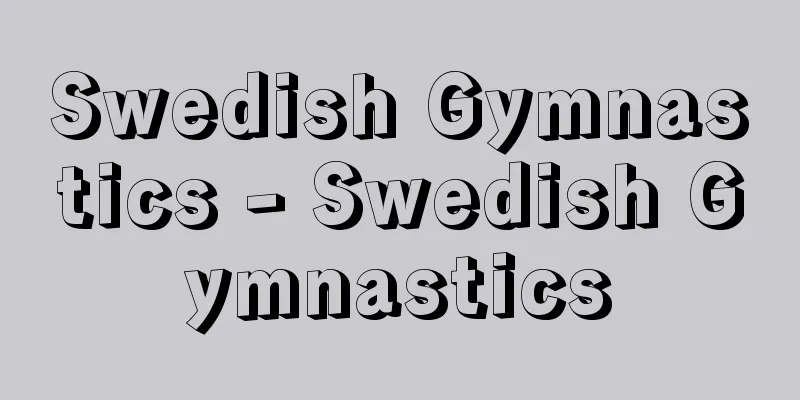Swedish Gymnastics - Swedish Gymnastics

|
A system of gymnastics invented by Swedish gymnast Per Henrik Ling (1776-1839) in the early 19th century. Based on the results of anatomy and physiology, he emphasized the rationality and scientific nature of gymnastics. He conceived his system of gymnastics based on four pillars: medical gymnastics to correct posture, military gymnastics focusing on bayonet fighting and fencing, educational gymnastics focusing on unarmed exercises, and artistic gymnastics expressing the beauty and freedom of gymnastics. However, none of these systems were completed. After his death, the Royal Central Gymnastics Institute took over this work and further research was carried out. In the mid-19th century, Ling's concept of healthy gymnastics, which encompasses medical, military, educational, and artistic gymnastics, gradually became clearer. The Swedish Gymnastics Federation further developed this concept of healthy gymnastics, and in 1911 it came up with the modern slogan "gymnastics for everyone." This trend was carried over to the "Trim Exercise" after World War II. Today's Swedish gymnastics is a mix of health and art, and is inherited as a form of exercise that combines flexibility and grace. It was first introduced to Japan in the early 1880s by Miyake Hide (a pioneer of modern medicine) who introduced its benefits as the "rebellious exercise method." After 1902, Kawase Genkuro and Iguchi Akuri began to provide practical instruction. The ideas in the "School Gymnastics Instruction Guidelines" established in 1913 were based on the principles of Swedish gymnastics, and these principles were inherited until Japan's defeat in World War II in 1945. Furthermore, the ideas of Swedish gymnastics were also introduced when radio calisthenics was devised in the early Showa period. Its influence on Japanese gymnastics is immeasurable. →Danish gymnastics/German gymnastics→Related topics: Stall bars Source : Heibonsha Encyclopedia About MyPedia Information |
|
19世紀初頭にスウェーデンのP.H.リングPer Henrik Ling〔1776-1839〕によって創案された体操の体系。解剖学・生理学の成果をふまえて,体操の合理性・科学性を強調。彼は体操の体系を4本の柱で構想。すなわち,姿勢を矯正するための医療体操,銃剣術やフェンシングを主とする軍隊体操,徒手体操を主体とする教育体操,体操の美しさ自由さを表現する芸術体操,の4本である。しかし,これらの体系はいずれも完成をみないで終わってしまった。彼の死後,王立中央体操研究所がこの仕事を引き継ぎ,さらに研究が進められた。19世紀半ばになると,リングの医療・軍隊・教育・芸術体操のすべてを包括する健康体操という概念が次第に明瞭になってくる。スウェーデン体操連盟はこの健康体操という概念をさらに進展させ,1911年には〈みんなの体操〉というこんにち的スローガンを掲げるにいたる。この流れは,さらに第2次大戦後の〈トリム運動〉へと引き継がれていく。こんにちのスウェーデン体操は健康と芸術をミックスした,しなやかさと優美さとを兼ね備えた体操として継承されている。日本へは1880年代の初めに三宅秀(近代医学の先駆者)が〈反抗運動法〉としてその効用を紹介したのが最初。1902年以降になると,川瀬元九郎や井口あくりらによって実践指導が行われるようになる。1913年に制定された〈学校体操教授要目〉の考え方はスウェーデン体操の原則に沿ったものであり,以後,1945年の第2次大戦による敗戦までこの原則は継承された。また,昭和初期のラジオ体操の考案に際しても,スウェーデン体操の発想が導入された。日本の体操に与えた影響は計り知れないものがある。→デンマーク体操/ドイツ体操 →関連項目肋木 出典 株式会社平凡社百科事典マイペディアについて 情報 |
Recommend
Imperial Court Ceremony - DairigishikiDairishiki
A book of court ceremonies from the early Heian pe...
Grass star - Kusaboshi
The Japanese name for the Pleiades. It is also cal...
Pollution Prevention Business Cost Burden Law
This law was enacted in 1970 to determine the sco...
Samoyedic peoples
Reindeer herders who live in the tundra region fro...
Asahi Kasei Corporation - Asahi Kasei Kogyo
A comprehensive chemical company that grew from a ...
Ego psychology
… [Psychoanalysis after Freud] Freud viewed the e...
Cassini's curve
...For a moving point Q on the ellipse x 2 - xy +...
Green Peas
An international environmental protection organiza...
Goya y Lucientes, Francisco José de
Born: March 30, 1746, Fuendetodos, near Zaragoza [...
Turgor movement
…All of these movements are characterized by bein...
Osuka [town] - Osuka
An old town in Ogasa-gun facing the Enshu Sea in s...
Neiva (English spelling)
The capital of Huila State in southwestern Colombi...
Nymphon japonicum (English spelling) Nymphonjaponicum
...adults are generally free-living, but many spe...
Royal Pavillion
…The construction of summer palaces flourished in...
Cypripedium guttatum (English spelling) Cypripediumguttatum
… [Ken Inoue]. … *Some of the terminology that me...









![Mabi [town] - Mabi](/upload/images/67cce9bcabd73.webp)